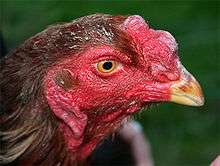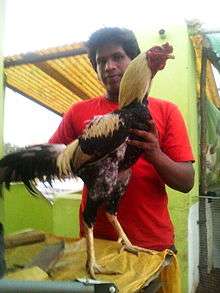Asil chicken



The Asil or Aseel is a breed of chicken originating from South Punjab / Sindh area of Pakistan and India.Also In Iran Called Lari most famous Rooster in Iran. fowl are found throughout Southeast Asia, such as Shamo and Thai Game. The breed is generally unstandardised in South Asia and India, but popularity has increased in the western world in recent times with the breed standardised in the British,[1] Australian[2] and American standards.[3]
Description and history
Asils were first used fighting cocks. Aseel is noted for its pugnacity. The chicks often fight when they are just a few weeks old and mature roosters will fight to the death. Hens can also be very aggressive towards each other.
Towards humans Asil are generally very tame and trusting. There are anecdotes where they have come to their keepers for other things than food, for example to get the keeper to open the door to the coop so they can get to roost.[4]
The hens are not good layers, but are excellent sitters. Laying depends on the Asil variety, the small Asil are known to be very poor layers, sometimes laying just 6 eggs a year, whereas larger Asil can lay around 40 eggs a year.
In the U.S., the breed is on the "Watchlist" (2012), by the Livestock Conservancy.[5] The Aseel breed is found in almost all states of India, but abundant in Andhra Pradesh.
Varieties

There are many varieties of Asil, some are standardized for shows such as the Reza Asil in the UK, some are simply named after the area where they are bred such as the Mianwali Asil from Pakistan or the colour, red/wheaten Asil are generally known as "Sonatol".
There are also hen-feathered Asil knows as "Madaroo" these are found in various colours, but the cocks come with feathers in hen colour, don't have sickle feathers in the tails and miss the large hanging feathers on the saddle. This variety is very rare.
Asil with feather beards under their beaks known as "muffed" and with tufts on the top of their heads known as "tasseled" are also seen, but are very rare especially outside India/Pakistan.
Bhaingam Asil variety have a large single comb but confirm to all the other Asil standards.
Broadly speaking, Asil in Europe are categorized and shown under these three types:
Reza Asil
Height: Up to 50 cm tall. Weight: Maximum weight for the hens is 1.8 kg, max weight for the cocks is 2.7 to 3 kg.
This type is standardized by the Asian Hardfeather Society in the UK and is seen at shows throughout the UK, but is quite rare.
This group of Asil reached worldwide popularity due to books and articles written by gamefowl experts such as Herbert Atkinson, Siran and Paul Deraniyagala from Sri Lanka and Carlos Finsterbusch from Chile. The Reza Asil family according to the old (Western) gamefowl literature is subdivided into following strains: (Amir) Ghan (Dark-Red), Sonatol(Light-Red), (Siyah) Rampur(Black), Kalkatiya (Kaptan)(Speckled-Reds) and Jawa(Duckwing). All these strains are identified by their specific color, these colors do not necessarily correspond with the area where the birds come from.
In colonial times other colors such as whites, spangles, golden etc. were regarded as inferior. At present day the "classic" strains and names given mentioned by Atkinson are more or less forgotten. The native people in India, Pakistan, Bangladesh and Sri Lanka only know the Reza-type Asil by their local names.
Reza Asil also available in maharashtra
Reza Asil available in Satona (Kh) 431502 Tq. Partur Dis. Jalna, Selgaon Tq. Partur, Malegaon Tq. Dhule Dist. Nasik
Kulang Asil
Height: Up to 75 cm tall. Weight: 5 to 7 kg.
The large Asil are divided into sub-varieties : North Indian, South Indian and Madras type. The North and South Indian varieties don't differ much. Only type of comb, shape of the beak and body shape are different. For example: Northern type = slender, Southern type = heavier build. The Madras Asil however is significantly different. They have a lower station, are heavier build and stronger boned. These birds often come in a bluish colour. This variety is found in the deep south of India, the Tamil Nadu state.
Sindhi Aseel

Sindhi Aseel or Sindhi Asil (Sindhi: سنڌي اسيل, Urdu: سندهي اسيل) is a breed of chicken and as from the name, originates from Sindh (one of 4 major provinces of Pakistan). These cocks, or fighting cocks, are noted being tall, heavy and good at fighting, so they are bred mainly for cockpit. These Aseels are characterised by a muscular but compact body, broad shoulders, wings carried against the body, short and hard feathers, drooping tails, a large curved beak similar to that of an eagle, pea comb and no wattles.
Mianwali
This breed is mainly found in Mianwali district of Pakistan. However, since its arrival, this breed has risen to popularity in Pakistan, currently the primary game breed used in the pits also preferred by gamblers. It is smaller compared to Sindhi aseels weighing between 1.5 and 3.5 kg depending on the preference of breeders. It is much faster and a better head hitter usually comes in small to medium height. A good Mianwali aseel should kill its opponent within a few minutes. They have been known to kill bigger roosters because of their speed and accuracy. They come in various colors such as Java(duckwing), Lakha (reddish), black and various others depending on the combination used in breeding. Very hard and a brave fighter with attitude to inspire, excellent in naked heels and metal spurs. There are many sub breeds of this breed owing to the combination used in breeding. A good tested Mianwali rooster would usually have offspring of a similar quality. Typical description would be small curved beak, strong joints, pearl/white/yellow eye color, short crow, small comb and do not have heavy body structure. May look smaller than other breeds but is excellent spurer.
Java Aseel
Java aseel is one of the most used and best fighter cock in Pakistan/India. It is mainly found in Punjab region, its origin was from Mianwali district, Jawa Aseel is recognized by his black and yellow colour.

It is also found in red and black colours and orangish most of the times.
It is usually mixed with desi cock breeds for superior fighting skills.
It's weak point is its long legs and eta more hits in fighting.. it is also found in South India in Kolar district of Karnataka belts
Height of Java Asil is 50 cm and Weight of Java is 7 to 8 kg.
Amroha
This is a rare breed of Aseel used in Pakistan and India. Very few of these roosters exist in their pure form. They are known to be small to medium like Mianwali. It is also known that they are champion of naked heel fighting. In simple, it is a fantasy of most aseel breeders in Philippines. they are very strong .mostly they found in two colors.
Bantam Asil
Weight: Up to 0.75 kg.
Bantam Asil have been created at the end of the 19th century by an English breeder named William Flamank Entwisle. The breed got very popular after its creation but after a couple of decades interest in this variety slowly died out. Until the beginning of the 1980s nothing was heard about these little Asil. A Belgian breeder named Willy Coppens created them again using Shamo (chicken), Indian Game and Reza Asil. The breed was also introduced again in the Netherlands and United Kingdom. At present day Bantam Asil are quite popular and they are bred in various colors.
Lasani Aseel Breed
Pakistani Aseel breeders have developed different varieties of aseel breeds. But one of the rarest breed is what they call Lassani Aseel breed. They are medium size birds with powerful strikes to earn them the title of neck breakers. This breed has a typical parrot like beak and small neck size. Unlike mianwali they have a particular fight style. They don't like jumping over the opponent rather they like to come closer to the opponent touching him with their front body and than attacking on the neck. So in a typical mianwali versus Lassani fight you will see mianwali birds dominating initially but as soon as they are tired of jumping around and land on the ground somewhat tired lasani breed cock will finish the game with a couple of hits in the neck. Amroha and lassani are closely related however lassani breeds have smaller necks and often closed eyes only few families of Nawab have got this breed in its pure form. And the notion that they are bengam type aseels is mistaken.[6]
References
- ↑ British Poultry Standards. Blackwell Publishing. 2008. p. 47.
- ↑ Australian Poultry Standards. Victorian Poultry Fanciers Association Ltd trading as Poultry Stud Breeders and Exhibitors Victoria. 2012. p. 188.
- ↑ "APA Recognized Breeds and Varieties" (PDF). American Poultry Association. Retrieved 18 January 2013.
- ↑ The game fowl colours, Owen Dickey, privately published
- ↑ "The Livestock Conservancy". The Livestock Conservancy. Retrieved 2014-04-29.
- ↑ "Asils Home - Andhraasil". Andhraasil.webs.com. Retrieved 2014-04-29.
- Oriental Gamefowl, Horst W. Schmudde, Authorhouse, ISBN 1-4208-7681-3
- The complete encyclopedia of chickens, Esther Verhoef & Aad Rijs, Rebo International, ISBN 90-366-1592-5
- "The Aseel (or Asil)". The Society for the Preservation of Poultry Antiquities.
- "Aseel". mypetchicken.com.
- "International World of Asil".
External links
| Wikimedia Commons has media related to Asil. |